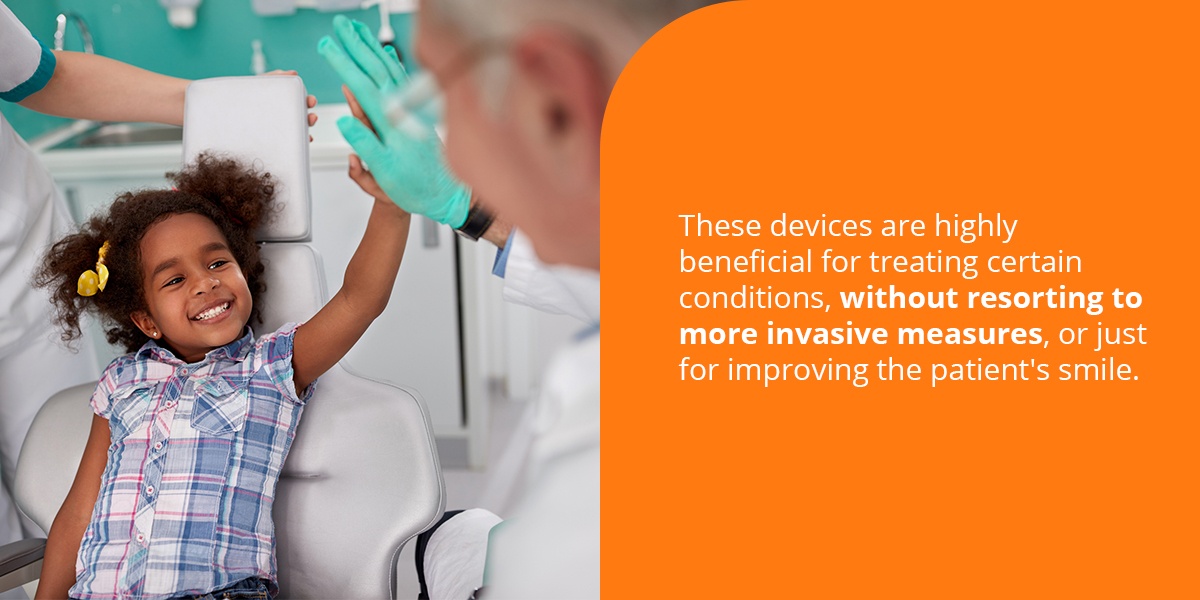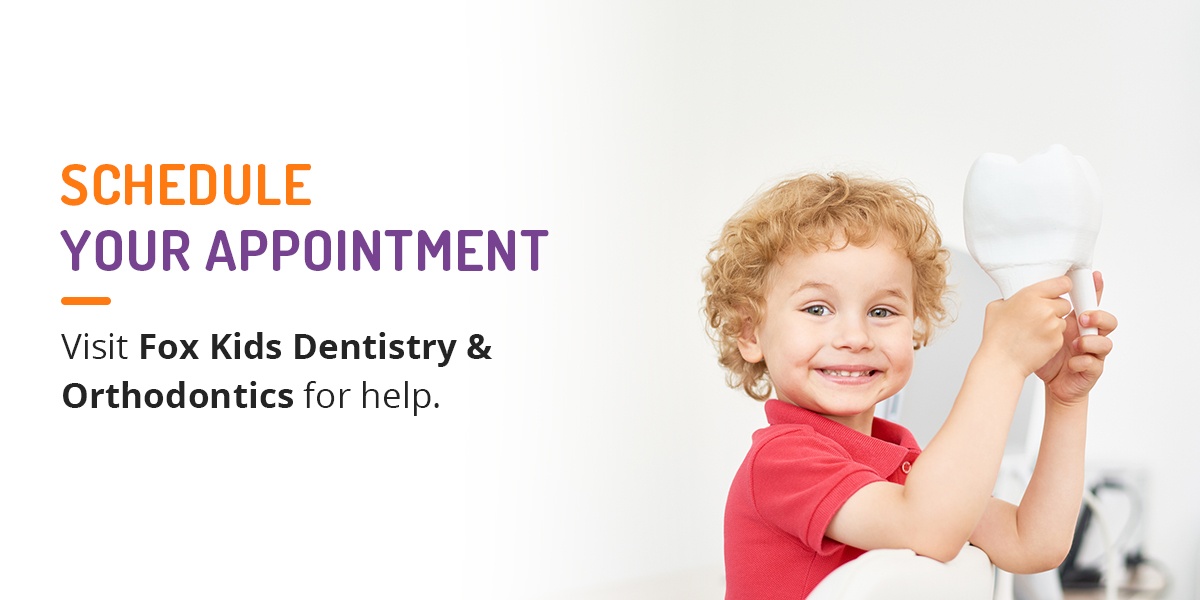When most people in Portland think of “orthodontists” and “orthodontics,” they immediately think of braces.
However, orthodontics is a much broader specialty of dentistry that focuses on cranial and jaw growth, as well as the alignment of teeth.
The term used to describe this area of orthodontics is “dentofacial orthopedics.” In fact, the most accurate (and correct) term for the specialty is now Orthodontics & Dentofacial Orthopedics.
Call to Schedule A Dental Consultation
Use the links below to jump to sections in this blog post.
-
- What Palatal Expanders Do
- Why We Use Palatal Expanders
- Does My Child Really Need An Expander?
- Types of Expanders
- How to Care for Expanders
- At What Age Should My Child Get an Expander?
- Will I Need a Retainer After My Expander?
- Are Expanders Used in Tandem With Traditional Braces?
- Can You Use an Expander With Invisalign?
- Will I Sound Different When I Talk With an Expander?
- Does an Orthodontic Expander Hurt?
- What Happens if We Don’t Do the Expander at the Correct Age?
- When Should My Child See an Orthodontist?
To correct jaw alignment, orthodontists will often use specific appliances, in addition to traditional braces.
These appliances are uniquely fabricated for addressing jaw problems.
There are many different types, styles and designs of these corrective devices. One of the most common of these appliances is an orthodontic expander.
Similar to how babies have soft spots on their heads which allows for further growth of the skull, kids and pre-teens have a soft spot on the roof of their mouths.
The technical name for this particular soft spot is the mid-palatal suture.
At the pre-pubertal stage in human development, the upper jaw consists of two sides (a left and a right side) connected by the soft spot (or mid-palatal suture) in between them. Think of this soft spot as a growth area that runs right down the middle of our upper jaw, allowing it to widen as a child grows.
Towards the end of a child’s growth, usually after puberty, this soft spot will fill in with bone and harden.
What Palatal Expanders Do
 An orthodontic expander takes advantage of the soft spot to widen the upper jaw. The appliance gets placed onto the roof of the mouth, usually by connecting it to the top back molars, and separates the left and right sides of the jaw, making it wider.
An orthodontic expander takes advantage of the soft spot to widen the upper jaw. The appliance gets placed onto the roof of the mouth, usually by connecting it to the top back molars, and separates the left and right sides of the jaw, making it wider.
When an orthodontist examines a young patient, one of the items they will be looking for is how the upper and lower jaws line up with each other. They will be able to diagnose at an early age if there is a narrow upper jaw that is in need of an expander.
Schedule an Appointment with our Pediatric Orthodontist
One of the most common indications of this is when the top back teeth bite inside the lower back teeth, which is called a crossbite.
In an ideal bite, the top teeth reside outside and cover all of the lower teeth, similar to how a lid covers a jar.
With a narrow upper jaw that is in need of an expander, crossbites will often be present.
Jaw misalignments and crossbites can also cause issues with biting. When the top teeth bite inside the bottom teeth, it often creates an unnatural biting surface for those teeth.
The body realizes that affected teeth aren’t biting how they should and it tries to change how we bite to protect the teeth. This is called a shift.
Altering how we naturally bite, or shifting, can lead to problems with the temporomandibular joint (TMJ) later in life. However, if the body does not alter how it bites, then teeth can undergo a traumatic bite that can jeopardize the long-term health of the teeth.
Traumatic bites can potentially lead to chipping or breaking of the enamel, which can permanently damage teeth. In either case, an expander can help to correct these problems.
Why We Use Palatal Expanders
Orthodontists use expanders for many different reasons. However, there are two main reasons that warrant the use of the appliance:
- The upper jaw can be too narrow compared to the lower jaw, like if one leg was longer than the other leg. To correct this, we use the expander to widen the upper jaw to match the size to the lower jaw.
- The upper jaw can be too small to fit the size of the upper teeth. When we widen the upper jaw with an expander, we gain space, which makes more room to fit all the upper teeth, hence alleviating the crowding.
Does My Child Really Need an Expander?

These devices are highly beneficial for treating certain conditions, without resorting to more invasive measures, or just for improving the patient’s smile. Problems that maxillary expansion can treat are:
- Crowding: If adult teeth lack enough space, widening the upper jaw can create room for them to fit. This might prevent the need to treat the area with tooth extractions.
- Crossbite: If the upper jaw is misaligned with the lower jaw because of how narrow it is, the top teeth in the back of the mouth will close inside the lower teeth instead of in the correct position. A crossbite is a type of jaw misalignment that can be corrected through the expansion of the upper jaw.
- Impacted teeth: If a tooth has failed to erupt fully or is blocked by other teeth, the upper jaw can be widened to give it enough space to take the proper position. This treatment is the most ideal for canine teeth.
- Aesthetics: Widening the upper jaw can broaden the smile in some cases. This treatment can be used as part of the process for correcting a narrow smile or a gummy smile.
Types Of Expanders

As mentioned above, there are many different types of dentofacial orthopedic appliances. In fact, within the family of appliances classified as expanders, there are many different styles.
The two main categories of expanders are fixed and removable. The difference between these two is that fixed expanders are glued into the mouth, while removable expanders are able to be taken out of the mouth, similar to a retainer.
Fixed expanders tend to be more popular because the removable kind can be easily lost and have the added hassle of constantly having to be inserted and removed. Furthermore, removable expanders often don’t get worn as much as they need to be by the patient.
Fixed expanders are usually connected to rings that fit snuggly around the back molars. These rings then get glued onto the teeth, thus securing the appliance.
The most traditional type of fixed expander is called a hyrax. A hyrax has a small lock in the middle of it that sits next to the roof of the mouth. The lock is turned with a key, which delivers the force to expand the upper jaw. The lock is turned at a rate prescribed by the orthodontist and will vary from patient to patient.
There are many types of fixed expanders in addition to a hyrax, such as a quad helix or a Haas expander.
How to Care for Expanders
Brushing the palatal expander is a necessity for keeping a healthy smile as your child undergoes orthodontic treatment. Gently brush the palatal expander twice daily or after each meal. Rinse with water after eating to clear out food particles, using antimicrobial mouth rinse occasionally.
A removable expander is easier to care for since your child can remove it from their mouth and clean it easily. If your child has a removable expander, they should still clean it at least twice a day.
At What Age Should My Child Get an Expander?
Timing is everything in life, and an orthodontic expander is no different.
The expander works best if we can widen the top jaw before the soft spot on the roof of the mouth fills in with bone. The solidification of the top jaw with bone usually occurs sometime during puberty.
Once the soft spot closes, surgery is the only mechanism to widen the upper jaw. To avoid surgery, it is vital that we accomplish upper jaw expansion at a young age, generally between ages 8-12, to take advantage of growth potential.
Set Up An Orthodontics Appointment
Will My Kid Need a Retainer After An Expander?
Most people have heard the term orthodontic “retainer” before. They are usually thought of as the slimy, often brightly colored mouthpieces that are built out of acrylic and wires. Retainers are used after orthodontic treatment to stabilize the teeth and jaws.
It is vital that we do the very best we can to preserve the correction we achieve during our orthodontic treatment. After all, too much time, energy and money went in to the orthodontic treatment to have the teeth shift back to how they started.
Usually, we will want to use retainers whenever we do any orthodontic treatment, including after an expander. There are some instances where patients won’t need to wear retainers after an expander, but that is on a case-by-case basis and will be decided by the orthodontist for your unique condition and treatment.
Are Expanders Used in Tandem With Traditional Braces?

It depends on the patient and what the treatment goals are. While expanders don’t have to be used with traditional metal braces, they often are.
The normal course of treatment is to begin with an expander by itself for a few months. We will use the expander as described above to correct the narrow upper jaw and make additional room for the teeth. When we use an expander, the patient will often get a gap between the front two teeth.
The gap is formed because the front two teeth are where the left and right sides of the upper jaw come together. When we expand the jaw and push the two sides of the jaw apart, the left and right sides separate from each other at the middle of the front teeth, forming a gap.
The teeth will normally drift back together over the next few months, and the gap will lessen or go away completely.
After we achieve our expansion in the upper jaw, the patient will be ready for braces. We will leave the expander in place and add the braces. This marks the beginning of the correction of the bite, crowding, spacing and rotations.
Once we have had the expander in place for the acceptable amount of time (typically 6-12 months), we can remove the appliance while the patient is still in braces and continue to achieve an ideal smile and bite.
One of the most fun and exciting parts of orthodontic treatment is that when braces patients come in for an appointment, they get to change the “color” of the braces. We don’t actually change the color of the braces themselves, but rather the colored rubber ties that hold the wire against the braces.
Fortunately for our expander patients, the appliances are made purely of metal and do not require the colored rubber ties. Furthermore, since the appliance sits on the roof of the mouth, it is seldom seen by anyone.
If our only concern is the narrow upper jaw and the position of the teeth is satisfactory, we will commence with the expander treatment and once complete, we will end treatment.
As with all orthodontic treatment, we will probably use a retainer at the end of treatment to “retain” and keep our correction stable.
Can You Use an Expander With Invisalign?
Yes! If the patient wants to avoid wearing braces and wants to use clear aligners (Invisalign) instead, we can coordinate the two treatments. Usually an expander is used first. We proceed with the expander treatment as normal. Once we achieve the desired expansion with the upper jaw, the expander will remain in place for 6-12 months depending on the condition.
When our expander treatment is complete, we will remove the appliance and use a retainer to hold our correction until we are able to begin our clear aligner treatment.
This is a great option for kids who want to correct their jaw alignment and straighten their crooked teeth without the use of traditional metal braces.
Will My Child Sound Different When They Talk With an Expander?
When most patients start out with an orthodontic expander, they have a slight lisp as they get used to the device. The lisp usually goes away for most patients, who start talking as they did before once their tongues adapt. Because the expander sits in the roof of the mouth, the tongue has to learn to move around it.
To speed up the process, talking out loud as much as possible after the expander is in place can help. Many patients find it helpful to read out loud to practice.
Does an Orthodontic Expander Hurt?
When we are able to do the expander at the correct age, it is usually a fairly painless procedure. The soft spot on the roof of the mouth easily separates and allows for effective, pain-free expansion. When the hyrax is turned, kids often feel a light sensation in the roof of the mouth, the teeth, the nose or the cheeks.
It usually is felt for just a few seconds after turning and quickly dissipates.
What Happens if We Don’t Do the Expander at the Correct Age?

If we are not able to begin our expander at the correct age, the soft spot in the roof of the mouth hardens into bone. Once the growth center closes, the expander can be a bit more uncomfortable for the patient.
Furthermore, the expander is not nearly as effective because it is only moving the teeth and not the jaw bone.
To widen the upper jaw after the suture closes, the patient must go through a surgical procedure. This entails a consultation, diagnosis and treatment plan by both an orthodontist and an oral surgeon. They will work together to coordinate treatment to achieve the desired result.
Surgery is easily avoidable by seeing an orthodontist at the correct stage of development, getting an early diagnosis and proceeding with the correct treatment.
When Should My Child See an Orthodontist?
The American Association of Orthodontics recommends children see an orthodontist by the age of 7. When it comes to expanders, we definitely want to take advantage of growth potential to avoid surgery and get the best result we can.
Most pediatric dentists are well aware of expanders and the great work they do, and will advise when is the right time for an examination by an orthodontist. However, when in doubt, it’s better to be on the early side of an exam rather than on the late side!
We offer complimentary orthodontic examinations with our board-certified orthodontist. If you are interested in a consultation, please contact our Portland office today!
Schedule Your Appointment
Do you or your child need an orthodontic evaluation? Visit Fox Kids Dentistry & Orthodontics for help. Call us at 503-223-5039 to schedule your visit to our downtown Portland location!


